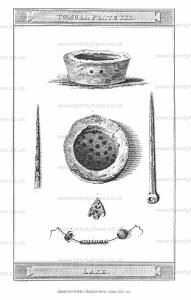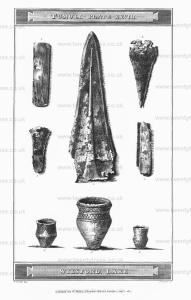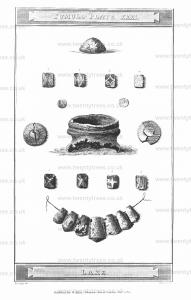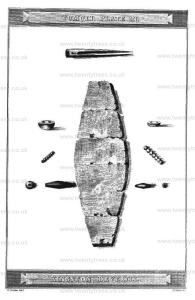Lake Barrows
Lake Barrows is in Station 5 Amesbury South.
At a short distance to the west, on the same fine of down, we meet with another fine group of barrows, which I have engraved on the same plate with the former group, and distinguished by the title of LAKE GROUP.
The diminutive barrow, No. 2 [Map], produced, just under the surface, the very rude and perfect little cup engraved in Tumuli Plate XXX, No. 1, which is perforated at bottom like a cullender, and has holes on the sides for suspension. This article seems to corroborate the idea I started in my Introduction, that these small vases might, without any great impropriety, be called INCENSE CUPS, in which aromatic oils and perfumes, according to ancient usage, were burned and suspended over the funeral pile. This cup accompanied an interment of burned bones.

No. 6 [Map] is one of the finest barrows in this group, and is 13 feet 9 inches in elevation. On making our section, the workmen had the good fortune to dig close to the side of a large sepulchral urn which stood within one foot of the surface, without injuring it. It was rudely formed and baked, measured 15 inches in height, and 13 in width and was placed with its mouth downwards over a large pile of burned bones, amongst which was a fine ivory bodkin, Plate XXX. No. 2. At a further depth of five feet were the remains of two skeletons; and at the bottom of the barrow, and total depth of 13 feet 9 inches, was an oblong cist, five feet deep, and seven feet long, cut in the chalk, containing the skeleton of a child, apparently not more than two or three years old, accompanied by a drinking cup.
The history of this tumulus, which our learned Doctor would, from its superior size and beautiful form, have styled a KING BARROW, shews what little regard we ought to pay to system; for here, at the vast depth of nearly 14 feet, we find only the deposit of an infant, accompanied by a simple drinking cup. Whilst in No, 21, a mean and insignificant barrow, we discover articles of the greatest beauty and importance. The motto of fronti nulla fides may be justly and strictly applied to barrows; and the antiquary who makes them his study must neither be disappointed in finding only a simple interment in the largest barrow, and the finest urns and most precious trinkets in the smallest. Curiosity, however, is equally kept on the alert; and it matters little whether we gain our information by the operations of the spade on a large or a diminutive tumulus.

No. 7 [Map] is a large bell-shaped barrow, composed entirely of vegetable earth. It contained, within a cist, a little pile of burned bones, with which had been deposited a very fine brass pin, a large stone bead which had been stained red, a bead of ivory, and a lance-head of brass, Plate XXX. No. 3, 4.

No. 8 [Map] is a very wide and flat barrow, elevated about six feet from the ground, and supposed to be the one from which the French Prophets1, about the year 1710, delivered their doctrines, as its summit presents an even surface of 48 feet in diameter. To ensure success in a mound of such magnitude, we were obliged to make a very large section, in which, at the depth of two feet, we came to the top of a pile of marl, which encreased in size as we approached the floor. After considerable labour we found, on the north side of our section, the cist from whence this marl had been thrown out; it was eight feet and a half long, and above two feet wide, and contained a pile of burned human bones, which bad been enclosed within a box of wood. Near the bones lay a fine spear-head, [Plate XXVIII. No. 7.] and a whetstone. From the singular form and extraordinary size of this barrow, we expected to have made more important discoveries; and though most probably we found the primary deposit in the centre or place of honour, it is not at all unlikely that the sides of this large mound might produce other sepulchral deposits.
Note 1. Dr. Stukeley says, that the country people call this group the Prophet's barrows, because the French prophets, 30 years ago (A. D. 1710 set up a standard on the largest barrow, and preached to the enthusiastic multitude." Among the multitude of protestants who fled from France in consequence of the horrible persecutions which followed the revocation OF the Edict of Nantz, were same enthusiasts, who pretended to the gift of prophecy, and other spiritual gifts. These enthusiasts travelled over various parts of the kingdom preaching ta the people, and according to tradition, the summit of one of these barrows was chosen as a fit place for the prophet's oration.

In No. 14 [Map] and No. 15 [Map] we see a kind of double barrow, the smallest end of which had been opened before. The floor of the larger mound was strewed with an immense quantity of wood ashes, and in a small oblong cist we discovered an interment of burned bones, together with four glass pully-beads, one of stone1, two of amber, and a brass pin. This last tumulus is separated from the former group by a bank and ditch, which once formed an old enclosure, for from its situation, and slightness, I cannot consider it as an encampment.
Note 1. The bead of stone, and one of glass, are engraved in Plate XXX. No. 6, 7.

On the north side of it, but not within its area, are a few small barrows, scarcely elevated. above the soil, which were more productive than their size seemed to promise.
No. 21 [Map] had been opened before; but. amongst the earth and scattered bones, we found some fragments of a fine drinking cup, some chipped flints, and one perfect arrow-head of flint.2
Note 2. Engraved in Plate XXX, No. 5.

No. 22 [Map] had also been partially opened, for amongst the unburned bones which had been moved, we found the remains of two neatly ornamented drinking cups; and an digging towards the south-east, we discovered the skeleton of a child, and over it a drinking cup.3
Note 3. Engraved in Plate XXVIII, No. 8.

and No. 24 [Map] produced a similar interment immediately under the turf with fragments of a drinking cup, Two feet lower down, we discovered another deposit of burned bones immediately over the head of a skeleton; and beneath this we found a second skeleton lying with its head towards the north-west, and several large pieces of stag's horns by its side.
In my description of this group of barrows, I made a deviation from the regular numerical course, and omitted those numbered 16, 17, 18, 19, 20. These claim a separate owner, under whose immediate inspection they were opened, and under whose fostering care the very singular and curious relicks which they produced, are cautiously preserved, at his venerable and picturesque old mansion-house in the adjoining village of Lake. These five tumuli were opened by the Rev. Edward Duke (age 32), in the year I806; and I am happy to think that the zeal he shewed in his first antiquarian researches was so amply remunerated, as to induce him to resume them on some future occasion; for few barrows ever proved so interesting as No. 19 and 20.
but though No. 20 [Map] [Note. This appears to be a mistake for 19?] had also a lance-head, the uniformity was most pleasantly broken by the discovery of four carious little articles of bone, which were intermixed with the ashes and burned bones. They are a perfect novelty, and had their meaning and use in British times; though in the more modern and enlightened period of the present day, we are at a loss to conjecture what that meaning and what that usage were. The obverse and reverse of each is faithfully delineated in Tumuli Plate XXXI by which you will perceive that the superficies is flat on one side, and convex on the other; they are made of bone, which appears to have been stained and polished by attrition; and each side is marked with a different pattern and device, except in one instance, where both sides are left blank. We might be led to suppose by this circumstance that the custom of casting lots existed amongst the Britons; and that these articles were appropriated to that purpose; or, perhaps, they might have been used like the ancient talus or tessera, for some kind of game. But in whatever light we view them, they must be considered as the greatest curiosities we have ever yet discovered; and as forming a slight progressive step towards language and civilization. 1
Note 1. The custom of casting lots prevailed in the earliest times amongst the nations antiquity, and a late ingenious traveller, Mr. Barrow, informs us that it is still continued in China.

No. 21 [Map] [Note. This appears to continue the previous mistake and number 20 as 21?] is a wide and low tumulus, over which the plough has performed its agricultural rites for many years. The mode of interment was here varied, and the very rich and numerous trinkets discovered in this barrow, seem to announce the skeleton to have been that of some very distinguished British female. The most remarkable of these, and unique in size, though not in pattern, was an ornament of amber, similar to that before engraved in Tumuli Plate III. but far exceeding it in all its proportions, being ten inches in height and above three in breadth; it is formed of eight instead of six distinct tablets, and by being strung together, formed one ornament, as may be distinctly seen by the perforations at top and bottom. Besides the above were numerous beads of amber of much larger proportions than usual, and varying in their patterns, four articles of gold perforated, perhaps for ear-rings, and two small earthen cups, the one about seven or eight inches deep, the other little above an inch. The largest of the beads, the gold ornaments, and the fragment of the smallest cup are engraved of their full size in Tumuli Plate XXXI.


Immediately on the back, or west side of this group of barrows, is an ancient bank and ditch, which in their northerly course may be traced to the junction of the Devizes and Deptford roads, where they are lost in the arable lands, when pointing towards the two British villages before described on Winterbourn Stoke down. You will also perceive by the map of this Station, that on the south side of the Wilsford group of barrows, two lines of bank and ditch run parallel with each other for a considerable distance, and ascending the hill, lead directly into another British village, where, on digging, we found the usual indicia of ancient population. In the intermediate space between these banks, are several barrows belonging to Mr. Duke, which were opened by him in the year 1806; but as their contents did not afford any particular novelty, and as I have already spoken much at large on this subject, I shall not enter into the detail of his researches: it would, however, be an injustice not to mention the very fine and perfect sepulchral urn which one of these tumuli produced, and which constitutes the principal ornament of Mr. Duke's Museum at Lake. On the west side of this bank, sepulchral memorials are very thinly scattered over the plain: but the numerous marks of old enclosures, and the rich appearance of the turf, flattered me with the hopes of discovering some British village. I was not, however, successful in my researches, though the spade was made use of in the most likely places; yet from the general appearance of the down, I have strong reason to suppose that onc existed in this neighbourhood.
At a short distance from the turnpike road, and nearly opposite to a solitary public house, dignified with the sign of the DRUID's HEAD, there is a cluster of barrows, so diminutive in size, that their elevation above the soil scarcely exceeds a foot. A leisure hour enabled me to ascertain the mode of interment that had been adopted, which was cremation. Four of the barrows contained sepulchral urns of the rudest texture, and the fifth a simple interment of burned bones. The greater part of the ground on the western side of the turnpike as far as the river Wily, is in tillage; chance, therefore, and a constant residence on the spot, can alone discover any settlement of the Britons in those parts; but a little to the south-west of the DRUID's HEAD, on the declivity of a hill, and still further to the south is a large square enclosure surrounded by an earthen agger; and still further to the south we meet with an ancient bank and ditch, which abut against the turnpike road and track way leading to some earthen works above Heale, which I shall describe hereafter.
Following the great road to Salisbury, we may observe a barrow on its side, which owing to the high ground on which it stands, becomes rather a conspicuous object. It is called Newton barrow, and must have been of much larger dimensions before it was ploughed over. We opened in July, 1805, but found that some antiquary, probably the Earl of Pembroke, or our good friend the Doctor, had been before hand with us. Our researches, however, were not totally fruitless or unproductive of novelty, as we found one amber bead, and a great many articles made of the teeth of some animal, and perforated, probably for the purpose of a rude necklace; the bones also that were dispersed about. a deep cist cut in the chalk, were strongly tinged with verditer, a proof that articles OF brass were once deposited within this barrow, whose history, we regret, was not recorded by those who investigated it. We afterwards opened two small barrows on the apex of the adjoining hill, but found that they also had been explored.
Following the turnpike road that leads to Salisbury, we meet with an ancient bank and ditch, which in a former part of my work [page 110] I noticed as coming from the ridge of Groveley wood, crossing the road from Deptford to Wilton near the village of Chilhampcon and the vale of Wily, and from thence pursuing its course across the Devizes road towards the vale of Avon. From the inequality of the ground where this bank seems to terminate, and from the commanding situation of the hill, I entertained a strong suspicion that a British village once existed on this spot, which was corroboratcd on a subsequent examination of the ground, by picking up the fragment of a well-turned vessel, and some other detached pieces of pottery; but all these probabilities ceased when I investigated it with the spade, for the fragments were too few in number, and too thinly scattered about the soil to warrant the supposition of a British settlement having existed on this eminence; but the most likely ground on its summit being corn, could not be properly examined. On directing my eye across the vale of Avon, I observed on the down near Little Durnford, a bank and ditch ascending the side of the hill, and which, from their direction, might have formed a continuation with those upon this eminence. As nothing interesting occurs in the interval between this spot and Salisbury, I shall return along the vale towards my head quarters at Amesbury. On a rough piece of heathy land to the west of Middle Woodford, I observed a little square earthen work with a slight vallum, and an entrance towards the east; some faint remains of a bank and ditch are still perceptible near the entrance to this work, from whence they descend into a vale, and are lost; but they seem to point towards a conspicuous eminence called Heale Hill, on the southern declivities of which our spade discovered the indicia of British population.1 A few barrows are seen dispersed over this tract of heathy land, and on the brow of the hill, projecting towards the vale, are the traces of a very ancient British work: the area comprehends about five acres: the vallum of the ramparts is slight, and the form represents an irregular circle: from these circumstances 1 am inclined to think this was a religious or judicial circle, not a military work; its elevated situation, commanding a most delicious view of the rich vale of Avon, fully answers to the positions usually selected by the Britons for such purposes.
Note 1. The lynchcts are very decidedly marked on the declivity of this hill, and, contrary to the custom of modern cultivation, run from tap to bottom, and not along the sides or the hill. One of these lynchets differs from the rest, and apparently forms an elevated terrace of approach to the British village.
A pleasant ride through the vale, near the picturesque old mansion-house at Lake, conducted me back to Amesbury.